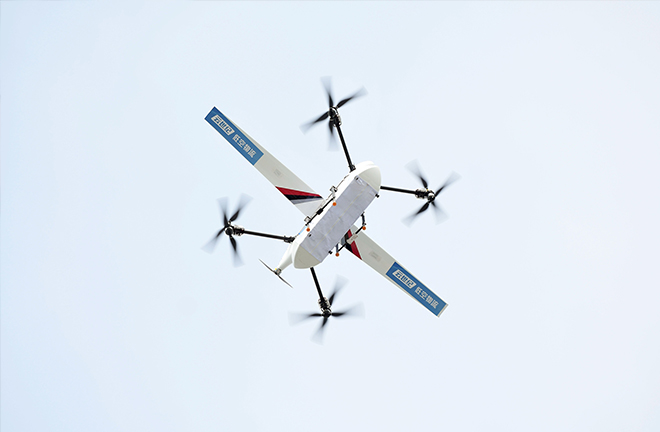Low-altitude economy takes off in favorable conditions

An umanned arial vehicle carrying seafood flies to a fishing port in Qingdao, Shandong Province, on Feb. 27. Photo: IC PHOTO
The low-altitude industry has emerged as a strategically significant and globally competitive sector. With an extensive industrial chain and diverse application scenarios, it plays a crucial role in modernizing China’s industrial system. As a key driver of new quality productive forces, the low-altitude economy holds immense potential for future economic growth.
Rapid development
China’s low-altitude economy is expanding rapidly, boasting a vast market and demonstrating strong growth potential. According to the Research Report on the Development of China’s Low-Altitude Economy (2024), the sector’s total output reached 505.95 billion yuan in 2023, reflecting a 33.8% year-on-year increase. Currently, aircraft manufacturing and operational services contribute the most to this boom, accounting for nearly 55% of the total output. Meanwhile, supply chain activities, production services, consumer applications, and transportation make up nearly 40%. Projections from the Civil Aviation Administration of China indicate that the sector’s market size will reach 1.5 trillion yuan by 2025 and is expected to grow to 3.5 trillion yuan by 2035.
Alongside this expansion, low-altitude operation services have also seen remarkable growth. By 2023, the number of general aviation operators had surged to 690 from 422 in 2018, while total flight operation hours rose from 937,100 to 1,536,000. The number of unmanned arial vehicle (UAV) operators witnessed an even more dramatic increase, rising from 4,402 in 2018 to 19,825 in 2023, with cumulative flight hours climbing from 15.78 million to 23.11 million.
Favorable conditions
Benefiting from sustained policy support and enriched application scenarios, China’s low-altitude economy has made significant strides in core technology research and development (R&D) and industrial integration, creating a strong foundation for further growth.
In recent years, the central government has increasingly prioritized this sector. The National Comprehensive Three-Dimensional Transportation Network Planning Outline, issued by the CPC Central Committee and the State Council in February 2021, formally incorporated the low-altitude economy into national planning for the first time, setting the stage for its development in top-level design. Subsequent references in the 2023 Central Economic Work Conference and the government work reports of 2024 and 2025 further solidified its status as a strategic emerging industry and a key engine of future economic growth. Responding to this policy momentum, local governments have successively included the low-altitude economy in their development agendas, unveiling action plans and implementation guidelines to clarify support measures and foster locally distinctive industry clusters.
China’s vast territory and super-large market have enabled a diverse range of applications for the low-altitude economy. Logistics has been a major focus, with leading Chinese logistics firms having invested in the R&D and testing of UVAs for over a decade. Beyond logistics, new application scenarios—including urban air mobility, low-altitude tourism and entertainment, agricultural and forestry monitoring, and emergency response—have been actively explored, providing ample space for further industry expansion.
Additionally, China has made significant progress in aviation manufacturing, UAV technology, communication and navigation systems, and air traffic management, strengthening the technical foundation for low-altitude economic development. The widespread adoption of UAVs, 5G communications, and intelligent air traffic management systems has enhanced both operational safety and efficiency in low-altitude airspace. Advances in flight control and power systems, as well as further integrations with digital technologies such as artificial intelligence, are making low-altitude aircraft more intelligent, safer, cost-effective, and adaptable to a broader range of applications.
Bolstered by policy incentives and increasingly rich scenarios downstream, China’s low-altitude economy has developed a competitive edge across its industrial chain. Upstream, the R&D, manufacturing, and sales of core materials and components have matured, with some enterprises fostering strong market competitiveness through technological innovation. Midstream, the manufacturing and service capacities for key products—including payloads, low-altitude flight systems, and ground infrastructure—are steadily improving. Meanwhile, the rapid expansion of the civil UAV industry is closely aligned with broader industry trends, as Chinese civil UAVs consistently account for approximately 70% of the global market.
To sum up, China has seamlessly integrated “low-altitude” with “economy,” continuously expanding application scenarios and nurturing the industry chain for the low-altitude economy, thus forging a unique path of low-altitude economic development with Chinese characteristics.
Zhang Zhongwen is an associate professor from the School of Applied Economics at Renmin University of China.
Edited by CHEN MIRONG
